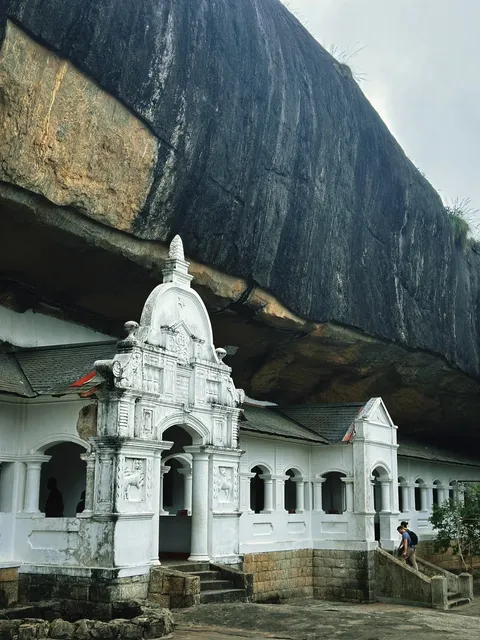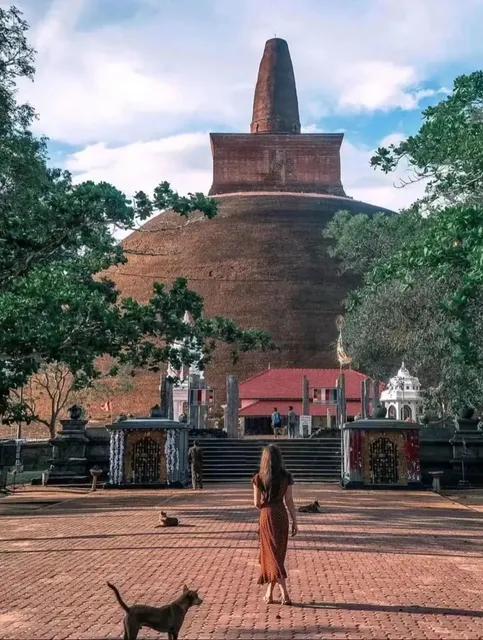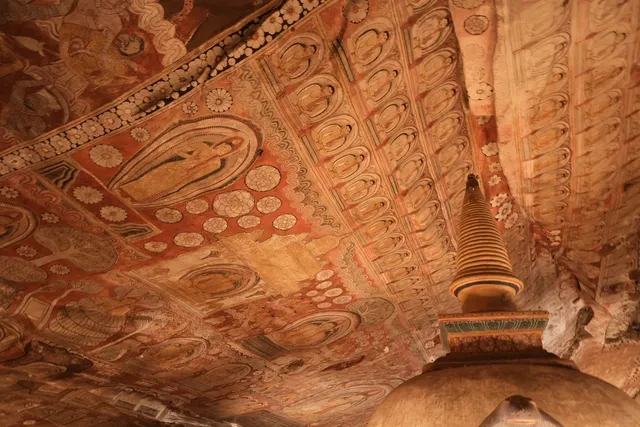The Dambulla Royal Cave Temple and Golden Temple is one of the most iconic cultural and religious landmarks in Sri Lanka. Located in the Central Province, near the town of Dambulla, this UNESCO World Heritage Site is the largest and best-preserved cave temple complex in the country. The site is a testament to Sri Lanka's rich Buddhist heritage and attracts thousands of visitors annually.
Key Features of Dambulla Royal Cave Temple Historical Background: The temple dates back to the 1st century BCE during the reign of King Valagamba, who sought refuge in the caves while in exile. After reclaiming his throne, the king transformed the caves into a Buddhist temple, which has since been expanded and maintained by subsequent rulers.
The Five Caves: The complex consists of five main caves, each adorned with stunning artwork and statues:
Cave 1: Devaraja Lena (Cave of the Divine King) Houses a 14-meter-long reclining Buddha carved out of rock and accompanied by statues of deities.
Cave 2: Maharaja Lena (Cave of the Great Kings) The largest and most impressive cave, featuring 56 Buddha statues and vibrant frescoes covering the walls and ceiling.
Cave 3: Maha Aluth Viharaya (Great New Monastery) Contains a large Buddha statue, frescoes, and paintings from the 18th century.
Cave 4: Paccima Viharaya (Western Temple) Known for its smaller, yet intricately decorated chamber.
Cave 5: Devana Alut Viharaya (Second New Temple) Includes several Buddha statues and paintings, though it is less ornate compared to the other caves.
Art and Architecture: The walls and ceilings are covered in frescoes depicting the life of the Buddha, Buddhist legends, and important historical events. The caves house 153 Buddha statues, as well as statues of Hindu deities like Vishnu and Saman, showcasing Sri Lanka’s historical interplay of religions.
Golden Temple: Situated at the base of the hill, the Golden Temple of Dambulla is marked by a giant golden Buddha statue, one of the tallest in Sri Lanka. This modern addition serves as a gateway to the ancient cave temple above.
Panoramic Views: The temple is perched on a rocky hilltop, offering stunning views of the surrounding plains, including landmarks like Sigiriya Rock Fortress.
Cultural and Religious Significance The site is an active place of worship and pilgrimage, attracting both local devotees and international tourists. The frescoes and statues provide insight into Sri Lanka’s Buddhist traditions and artistic achievements over two millennia. Visiting Information
Location: Approximately 150 km northeast of Colombo and 72 km from Kandy, making it a popular stop on the cultural triangle route.
Access: Visitors must climb a series of steps to reach the cave temple. The climb is manageable and offers scenic views.
Entry Fee: A fee is charged for foreign tourists, with free entry for Sri Lankan residents.
Dress Code: Visitors are required to wear modest clothing covering shoulders and knees as a mark of respect. Shoes must be removed before entering the temple.
Best Time to Visit: Early morning or late afternoon to avoid the midday heat and enjoy the serene atmosphere.
Tips for Visitors:
Bring water and a hat to stay hydrated during the climb. Photography is allowed, but flash is prohibited inside the caves to protect the artwork.
Watch out for monkeys around the temple complex. The Dambulla Royal Cave Temple and Golden Temple is a must-visit for history enthusiasts, art lovers, and spiritual seekers. Its breathtaking art, historical depth, and cultural significance make it one of Sri Lanka’s most treasured...
Read more🏛️ Dambulla Royal Cave Temple – A Sacred Sanctuary in the Heart of Sri Lanka
Located at an elevation of approximately 1,118 feet above sea level, the Dambulla Royal Cave Temple is one of Sri Lanka’s most significant Buddhist sites. It sits strategically between three ancient capitals: Anuradhapura, Polonnaruwa, and Kandy.
🗺️ Historical Background
🔍 Archaeological evidence reveals that this area was inhabited since prehistoric times, with burial sites from the Stone Age to the early historical period.
🛕 When Buddhism spread to Sri Lanka from India, this rocky outcrop was transformed into a sacred site. Natural caves were gradually expanded into monastic shrines for monks and royal patrons.
👑 King Valagamba (Vattagamini Abhaya), who once took refuge here during exile, was the first to sponsor and transform the site into a Buddhist monastery.
🎨 Over the centuries, several monarchs continued to enhance the temple complex, particularly during the Kandyan period (18th–19th century CE), leaving behind stunning artistic and architectural legacies.
⛩️ The Five Main Caves
Cave 1: Deva Raja Viharaya (Temple of the Divine King) The oldest of the five, this cave houses a large reclining Buddha statue, surrounded by serene paintings and a quiet, reverent atmosphere.
Cave 2: Maharaja Viharaya (Temple of the Great Kings) The largest cave, it features multiple Buddha statues, an image of King Valagamba, and the “eternal water pot”, a drip-fed vessel that never runs dry. The walls are adorned with colorful murals depicting Buddhist tales and Hindu deities such as Ganesha and Skanda.
Cave 3: Maha Alut Viharaya (Great New Temple) Constructed by King Kirti Sri Rajasinghe, it contains a 30-foot reclining Buddha and several seated and standing Buddha images.
Cave 4: Paccima Viharaya (Western Temple) A small, intimate chamber with modest murals and Buddha statues, offering a quiet retreat from the crowds.
Cave 5: Devana Alut Viharaya (Second New Temple) Originally used as a storage area, this cave was later converted into a shrine with a reclining Buddha and decorative elements.
🎨 Art & Architecture
The interiors of the caves are richly adorned with mural paintings and Buddha statues, showcasing styles from different historical periods. The Kandyan art style is especially prominent, marked by:
Golden-hued depictions of the Buddha
Red backgrounds
Robes with wave-like patterns
Murals illustrate key episodes from the Buddha's life, such as:
The First Sermon
Seven days of walking meditation after Enlightenment
You’ll also find statues of Bodhisattva Avalokiteshvara, Hindu deities, and ornate Makara Toranas (dragon-arch motifs), a hallmark of Sri Lankan art that later influenced Sukhothai and Rattanakosin art in Thailand.
☁️ Atmosphere & Visitor Tips
The surroundings are peaceful and spiritual, with breathtaking views from the mountaintop. The temple complex is ideal for those interested in history, religion, and art. There is ample parking at the base, followed by a 10–15 minute stair climb to...
Read moreDambulla Royal Cave and Golden Temple is a World Heritage site recognised by UNESCO. It is highly recommended to visit both the temples for the architecture and the giant statues of Lord Buddhe in different avatars. First you get the Dambulla Golden Temple. Unfortunately, I was not allowed inside since I was a foreigner but I could watch the huge statue from the outside. Next is the Dambulla Royal Cave Temple. If you are going by a vehicle, you can go a few metres ahead from the Golden Temple, take a right turn to go directly to the ticket counter for Royal Cave Temple. Since the road was under construction, we had to start our climb from the Golden Temple at the bottom all the way to the Royal Cave Temple at the top. Once you reach the waypoint, you will be directed to the ticket counter where one needs to pay 2000 LKR per head to gain entry into the temple. The trek took us 45 minutes to climb and at times, the steps are steep. It is not recommended to bring kids and elderly people to climb. It gets tougher as you progress and if you are not physically fit, refrain from doing this. Once you reach the top, you will see the temple entrance arch. You can remove your shoes at the show stand and to be respectful to their culture, please wear appropriate attire like shoulder covering shirt and knee and ankle covering sarong or pant. If you don't have one, you can rent one next to the show stand for 100 LKR. Once you enter the temple premises, the security will punch your ticket as part of authentication. Post that, you will find 5 caves with humongous sized Buddha statues and around 150+ different avatars of Lord Buddha during his life. The architecture is astonishing and the statues, carvings, painting and the artwork are top notch. The attention to detail is beyond expectations. Take some time out and read the signs in front of the statues and do not rush your visit. You will return happier once you know the history and prominence of the place. There is a small pond outside the temple premises which hosts a lot of Lotuses. It is a great scene. You will also get Lotuses and other items that you can offer to Lord Buddha as worship and seek his blessings. Show stand costs are optional and you can tip according to your convenience. There is a tap outside the premises to wash your feet, hands and face. Once you start getting down, you will find a lot of places selling fresh fruits, coconut water, fridge magnets, sodas and juices, etc and other items that one...
Read more


